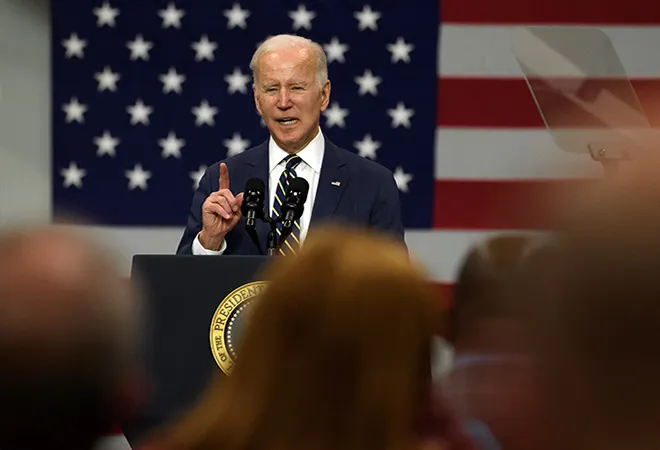-
CENTRES
Progammes & Centres
Location
The Biden administration’s inability to compete on two strategic fronts sets it on the back foot

The unfolding game of chicken between Russia and the United States (US) and EU over Ukraine is classic geopolitics, reminiscent of Cold War negotiation patterns and lingering political and security stakes from that period. Massive troop buildup by Russia on the borders of eastern Ukraine, while reflective of the potent Russian intent at aggression and even invasion, is an attempt to demarcate the de facto Russian sphere of influence. If the 2008 invasion of Georgia and 2014 invasion of Crimea and eastern Ukraine were incremental steps, Russia seeks a fundamental restructuring of the balance of power that was put in place by a dominant West after the collapse of the Soviet Union through Ukraine. The structural and institutional balance in eastern Europe extended by trans-Atlantic security guarantees such as NATO and Organisation for Security and Cooperation in Europe (OSCE) stands challenged in the face of Russian security and political demands which, if met, could alter US role in the region.
The battle lines are being drawn by an approach that straddles an appetite for negotiations with decisive response options ning military, economic, technical areas.
Russia has reportedly amassed 130,000 troops near the Ukrainian border, with a strong possibility of more troops coming in. Importantly, Russia has brought in many of its strategic enablers to support a full-scale military operation if needed. This includes anticipatory arrangements of logistics and medical supplies. On the other front, the US has put 8,500 troops on alert for a possible deployment in eastern Europe to strengthen NATO defenses, even as it continues to send additional security assistance to Ukraine. Biden administration’s strategy to deal with Russian aggression on Ukraine has been multipronged. Biden has sent his Secretary of State to Ukraine in a show of support, he has spoken with the Russian leader twice, has led multiple talks in Europe, has tried to pursue a diplomatic path alongside a comprehensive plan to retaliate both economically and military should Russia go ahead with an invasion into Ukraine. In response to Russia’s threat of a ‘military-technical’ response should its demands not be met, the US has detailed the ‘costs’ on Russia in the wake of an invasion of Ukraine, which includes crippling economic, technological and military sanctions including on key state banks and financial institutions in Russia. The battle lines are being drawn by an approach that straddles an appetite for negotiations with decisive response options ning military, economic, technical areas.
As the US seeks a strategic reorientation from a Euro-Atlantic focus to an Indo-Pacific centric approach, Russia senses an opportunity to clearly demarcate and consolidate its regional and global interests. There is also a sense of immediacy and decisiveness in Russia’s moves this time which is undergirded by the twin recognition of a global scramble by China to consolidate its own version of its traditional sphere of influence, but more importantly, by the realisation of a weak American moment. A fractured socio-political milieu at home, divided Congress, low Presidential approval, American decision to withdraw from Afghanistan, and perhaps the lowest appetite for a military commitment abroad may have all contributed to the nature and timing of the Russian decision to initiate military buildup in order to extract concessional strategic guarantees. In fact, Biden’s omission of war as an option in its declaration of ‘costs’ on Russia, should it invade Ukraine, might have actually played into the hands of Moscow. Russia’s open demands from the US which stipulates keeping Ukraine out of NATO forever as well as to keep former Soviet Union states free of NATO deployments, signal a conviction in Moscow that the US’ limitations under Biden could compel some costs on the US.
Russia’s open demands from the US which stipulates keeping Ukraine out of NATO forever as well as to keep former Soviet Union states free of NATO deployments.
Biden’s options vis-à-vis Russia have been hamstrung by a mix of unsteady signals and threats from Russia. While Russia’s troop buildup at the eastern borders of Europe, its direct threats of ‘military and military-technical response’, US’ pull out of the family members of its diplomatic staff from multiple cities in Ukraine showcase the palpability of a real and present danger, Moscow’s repeated insistence that there will not be any invasion of Ukraine and its obvious interests in drawing concessions through talks reflect smart manoeuverings of a touch and go strategy. This is best depicted by the heart of Russian strategic ambiguity which lies in the Putin’s assertion that Russia “doesn't want armed conflicts or bloodshed” but has “has every right” to take steps that ensure the country’s security and sovereignty. Despite these latent assurances, the recent cyberattack on Ukraine has depicted a real appetite of Russia to follow through on its warning that it will create vulnerabilities for the West.
Russia’s broader Eurasian scramble has added to Biden’s response conundrum. Russian recently seized the opportunity to send troops to arrest the Kazakhstan crisis, invoking the Collective Security Treaty Organisation (CSTO) treaty obligations for the first time in its institutional history. Through this move, Putin not just reaffirmed toehold in its ‘sphere of influence’ but reassured the possibility of swift action in any future crisis in the former Soviet Union space, including in Ukraine. Furthermore, it is increasingly getting difficult for the US to extract a unified position on Ukraine from the EU. Europe’s reliance on Russia for its energy supplies is another factor that could limit the US’ ability to muster a united EU front against Russia in the current crisis. While some countries have lent support to present a unified front against Russia by sending military and logistical support, other important nations, especially Germany, remain guarded amidst fears of a midwinter energy cut off of Russian gas looming large. Russia supplies about one-third of Europe’s natural gas. Despite US threats that it would halt the opening of the Nord Stream 2 pipeline, German reluctance in sending troops and armament to Ukraine has sent mixed apprehensions emanating from its policy of historical restraint and its current energy needs. Perhaps, a more acute problem than the political division in Europe on Ukraine is the Kyiv’s own dissonance with the American narrative on the gravity of threat posed by Russia. Ukraine has disapproved Biden administration’s assessments of the threat of invasion from Russia. This variance in European and American assessments of the current stand-off in eastern Europe evinces a prioritising of a broader interest-based approach by Europe to one that centres around security assurances extended by NATO and the US alone.
Europe’s reliance on Russia for its energy supplies is another factor that could limit the US’ ability to muster a united EU front against Russia in the current crisis.
At the operational level, Biden knows the limitations and costs of competing on two fronts with two grand strategies: With Russia in Eurasia and China in the Indo-Pacific. The Biden administration may also be feeling the pressure of ceding strategic operational space to China in the Indo-Pacific, should it focus more on Russia. Some of these strategic apprehensions are encapsulated in the US’ Indo-Pacific policy which points to China as the primary strategic competitor in its Indo-Pacific policy instead of Russia. In some ways, Washington’s recent warning to China to ‘stay away’ from Taiwan during the Ukraine crisis is an acknowledgement of the same, as China is likely to seek an opportunity to defend its ‘core interests’ at a moment when the US is strategically hamstrung.
There is a fundamental dichotomy in the demands of Russia over Ukraine and those of the NATO members led by the US—one that pulls the trans-Atlantic alliance from opposite directions. Moscow’s demand for a separate Russia-NATO treaty has been declined by the US as a ‘non-starter’ because the US understands that the NATO guarantees Europe’s geographic, demographic, economic, and military resources. Beyond the question of influence in Europe, the US’ preparations for a stronger response to Russia’s possible invasion of Ukraine, especially than the one meted out in the 2014 Crimea takeover, are geared to signal stronger alliance resolve and reassurance—perhaps the two important building blocks of post-war American hegemony. For the Biden administration these are important issues, given the preceding Trump administration’s policies that hit at the core of US alliance systems, be it in the Pacific theatre or the trans-Atlantic ties. Coming on the back of a disastrous troop pull-out from Afghanistan, a possible Russian invasion of Ukraine will undoubtedly lead to a loss of face for the Biden, both at home and abroad. Globally, it will be yet another dent in American influence and power. Domestically, it could prove disastrous for Biden’s approval ratings and, in turn, for the upcoming midterms later this year.
The views expressed above belong to the author(s). ORF research and analyses now available on Telegram! Click here to access our curated content — blogs, longforms and interviews.

Vivek Mishra is Deputy Director – Strategic Studies Programme at the Observer Research Foundation. His work focuses on US foreign policy, domestic politics in the US, ...
Read More +